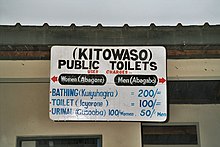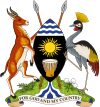|
Languages of Uganda
 In Uganda, the most spoken language in the capital city is Luganda, followed by English (also the official language since 1962), as all schools in Uganda use it in their studies due to the introduction of English during the colonial period. English is also the language of business and judicial matters.[1] Most spoken after Luganda and English is Swahili.[1] This language is more common in neighbouring Kenya and Tanzania. Swahili is taught in schools as an optional additional language and it is mostly spoken by the Ugandan army. In 2005, there were talks to include Swahili as the second official language as it was seen as neutral, however this is still not ratified by the government.[1] Swahili is used among some communities bordering South Sudan and Kenya.[2] Uganda is a multilingual country with over 70 generally estimated languages spoken. 43 of its living languages[3] fall into four main families—Bantu, Nilotic, Central Sudanic and Kuliak. Of these, 41 are indigenous and 2 are non-indigenous. Furthermore, 5 are institutional, 27 are developing, 7 are established, 2 are endangered, and 2 are almost extinct. There is also a Ugandan Sign Language. Languages In all of the Bantu-speaking areas of Uganda, dialect continua are very common. For example, people around Mbarara speak Runyankore and people from Tooro Kingdom speak Rutooro, but in between those areas there are villages where most of the people speak a dialect that is best characterised as intermediate between Runyankore and Rutooro. In fact, prior to 1952, these and other closely related dialects had a shared literature under the name of Runyoro (Runyoro, Rutooro, Runyankore, Rukiga, Ruhema, Runyambo, Ruhaya) since they are all mutually intelligible. In 1952, however, separate orthographies were developed for Runyoro and Rutooro (Runyoro–Rutooro) and for Runyankore and Rukiga (Runyankore–Rukiga). Around 1990 the term Runyakitara, which is not attached to any modern ethnic group but to the cultural heirs of the Empire of Kitara, was popularised to refer to the whole language cluster as well as to facilitate work in these languages, such as teaching at university level (Makerere). Nevertheless, a unified orthography is yet to be developed and spread.[citation needed] In south-central Uganda, the Bantu languages of Luganda and Lusoga are largely interintelligible as well. This dialectic similarity also extends to the Lussese language spoken in the Ssese Islands of Lake Victoria.[4] Nilotic languages include Karamojong of eastern Uganda (population 370,000), the Kakwa language in the extreme northwestern corner (about 150,000 population) and Teso south of Lake Kyoga (3.2 million 9.6% of Uganda's population). Western Nilotic Luo languages include Alur (population 459,000), Acholi, Lango, Adhola and Kumam. Some Southern Nilotic Kalenjin languages are spoken along the border with Kenya, including Pökoot and the Elgon languages near Kupsabiny. Kuliak languages Ik and Soo are spoken in northeast Uganda. Lugbara, Aringa, Ma'di and Ndo of northwestern Uganda are members of the Central Sudanic languages. Language policyIn Uganda, as in many African countries, English was introduced in government and public life by way of missionary work and the educational system. During the first decades of the twentieth century, Swahili gained influence as it was not only used in the army and the police, but was also taught in schools. The Baganda viewed the introduction of Swahili as a threat to their political power and partly through their influence, English remained the only official language at that time.[citation needed] After independence, there were efforts to choose an African official language, with Swahili and Luganda as the most considered candidates. Although Luganda was the most geographically spread language, people outside Buganda were opposed to having it as a national language.[5] English remained the official language.[6] Ugandan English, a local dialect of English, is largely influenced by native languages of the Ugandan people but very similar to both the British and American English. Uganda National Kiswahili CouncilIn 2011, the government of Uganda revealed plans to establish a Swahili language council to boost the teaching of the Swahili language in the country. It was not until September 9, 2019 that the cabinet passed resolution to create the National Kiswahili Council.[7] The National Swahili Council is meant to guide the planning process, implementation of interventions and allocation of resources to the usage and development of Kiswahili as a lingua franca – a language that is adopted as a common language between speakers whose first languages are different. References
Further reading
|
||||||||||||||||||



